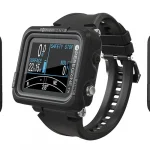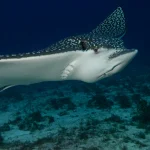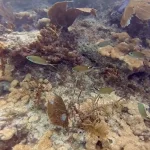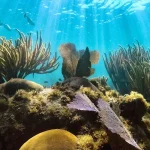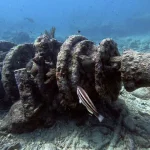Table of Contents
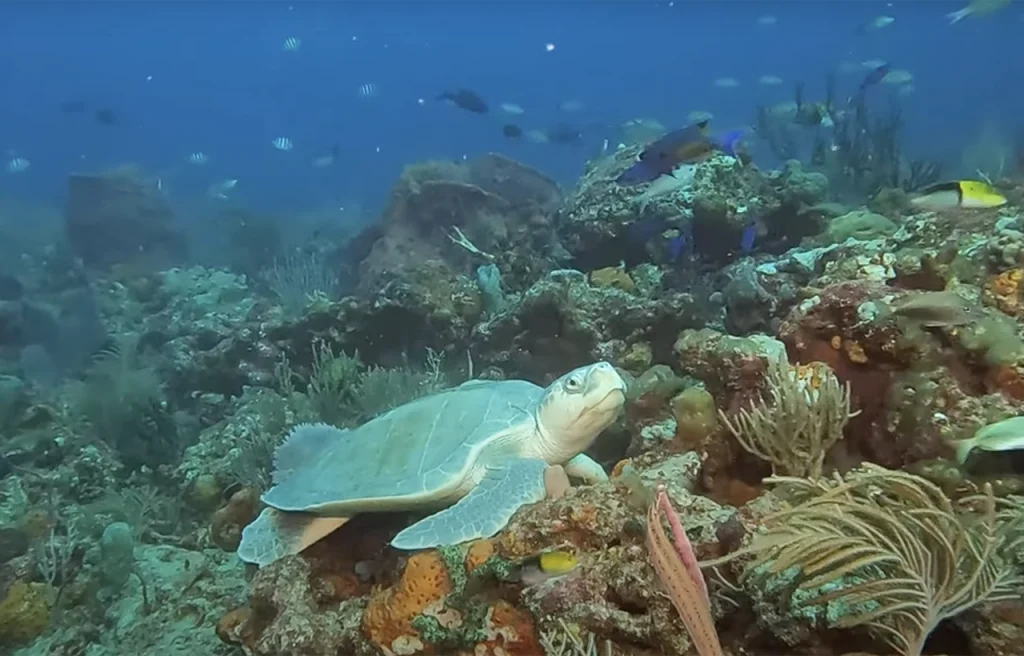
Bath and Tennis Reef offers a rich diving experience with opportunities to observe both large marine animals like turtles and sharks as well as vibrant reef fish in a stunning coral environment.
Article at a Glance
- Depth Range: The reef ranges from 42 to 60 feet (13 to 18 meters), making it accessible for both beginner and advanced divers.
- Visibility: Typically 30 to 50 feet (9 to 15 meters), with clearer conditions during summer months (May to August).
- Marine Life Highlights: Frequent sightings of loggerhead and hawksbill turtles, nurse sharks, moray eels, and vibrant schools of tropical fish.
- Unique Features: Explore ledges, crevices, cleaning stations, and colorful coral formations that support diverse marine ecosystems.
- Diving Conditions: Mild currents make the site ideal for drift diving, allowing divers to effortlessly explore the reef.
- Best Time to Dive: Summer months (May–August) offer warm water temperatures (74°F–82°F) and calm seas.
- Photography Opportunities: Capture stunning reefscapes, close-ups of marine life, and dramatic underwater topography with excellent natural lighting.
Bath and Tennis Palm Beach
The Bath and Tennis Reef in Palm Beach, Florida, is a popular diving site known for its vibrant marine life and excellent underwater conditions. Located off the coast of West Palm Beach, it is accessible by boat and features a mix of soft coral communities, reef fish, and larger marine species such as sea turtles and nurse sharks. The reef’s west-facing ledges create dramatic underwater landscapes with crevices and overhangs that attract diverse marine life.
Key Features:
- Diving Conditions: Visibility typically ranges from 30 to 50 feet, with water temperatures around 74–76°F. Drift diving is common due to the Gulf Stream currents.
- Accessibility: The reef is boat-accessible and suitable for divers of varying skill levels due to its manageable depths (42–60 feet).
What Marine Life Can I Expect To See?
Common Marine Life
- Sea Turtles: Loggerhead and hawksbill turtles are frequently spotted. Loggerheads can weigh up to 500 pounds and are known for their large, block-shaped heads.
- Sharks: Nurse sharks are often seen resting under ledges, while larger reef sharks may occasionally appear.
- Eels: Various species of eels, including green morays and sharptail eels, are common. They can often be found in crevices or near cleaning stations with small fish like gobies.
- Rays: Eagle rays are sometimes observed, particularly during certain seasons.
Reef Fish
The reef is home to a plethora of colorful reef fish:
- Angelfish: Blue angelfish and other species like the bicolor angelfish are prevalent.
- Groupers: Various groupers, including coney and golden groupers, inhabit the area.
- Tropical Fish: Expect to see schools of grunts, jacks, spadefish, and porkfish swimming around the reef.
Coral and Other Inhabitants
Bath and Tennis Reef features a mix of hard and soft corals that provide habitat for numerous small fish and invertebrates. The presence of cleaning stations attracts various species that rely on cleaner shrimp and small fish to remove parasites from their bodies.
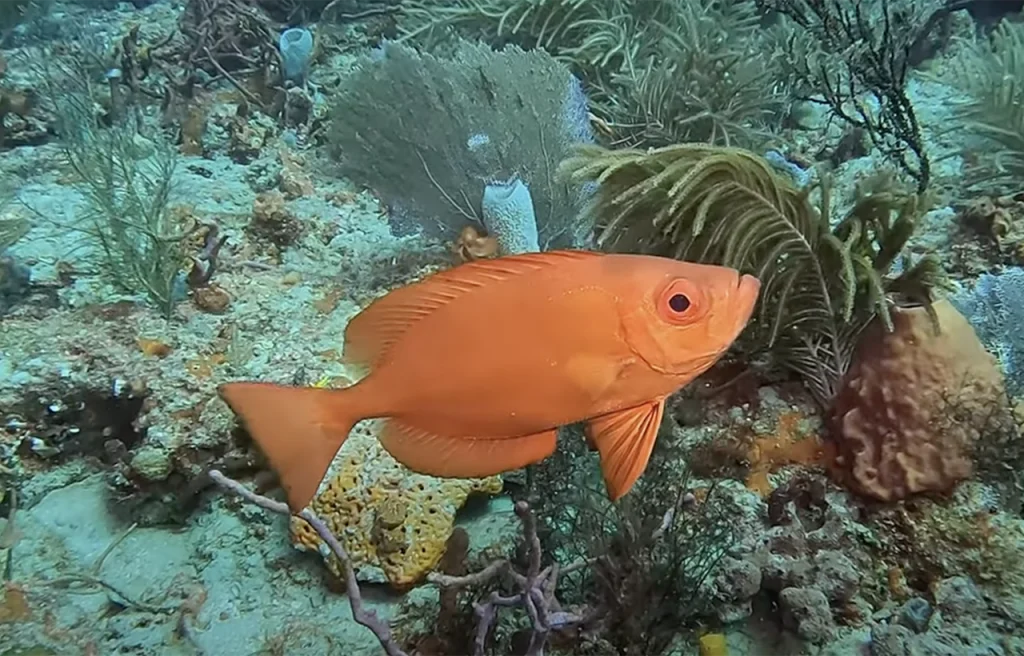
What Do Divers Say About This Site?
Abundant Marine Life
- Diverse Species: Many divers report seeing a variety of large marine animals, including sea turtles, nurse sharks, and eels. The reef is also home to numerous tropical fish, creating a lively underwater environment.
- Miniature Wonders: In addition to larger species, divers enjoy discovering smaller creatures like nudibranchs, whip coral shrimp, and various blennies, highlighting the reef’s rich biodiversity.
Diving Conditions
- Visibility and Temperature: Divers frequently mention good visibility, often between 30 to 50 feet, and pleasant water temperatures around 74-80°F. These conditions contribute to enjoyable dives.
- Current: The current is generally mild, making it suitable for divers of various experience levels. Many divers appreciate the ease of navigating the reef without strong currents hindering their exploration.
Overall Experience
- Engaging Environment: Divers describe the experience as immersive and rejuvenating. The combination of exploring colorful corals and interacting with marine life keeps divers engaged throughout their dives. One diver noted that even after years of diving, the excitement of discovering new aspects of the reef never fades.
- Community and Support: Many divers commend the local dive operators for their professionalism and support during dives, enhancing the overall experience.
Key Information
| Category | Details |
|---|---|
| Location | Palm Beach, Florida |
| Depth Range | 42 to 60 feet (13 to 18 meters) |
| Visibility | 30 to 50 feet (9 to 15 meters) |
| Water Temperature | 74°F to 82°F (23°C to 28°C) |
| Best Time to Dive | May to August |
| Suitable For | Beginners and advanced divers |
| Current Conditions | Generally mild or non-existent |
| Marine Life | Turtles, eels, nurse sharks, tropical fish |
| Unique Features | Coral formations, ledges, cleaning stations |
| Photography Opportunities | Vibrant corals, diverse marine life, underwater landscapes |
| Recommended Gear | Underwater camera, strobes, dive light |
Highlights of Diving This Site?
Marine Life Encounters
- Turtles: Divers frequently encounter loggerhead and hawksbill turtles, often swimming alongside schools of fish or resting on the reef. Their presence adds a magical element to the dive experience.
- Eels: The reef is home to various eels, including green morays and sharptail eels, which can often be seen at cleaning stations surrounded by colorful gobies.
- Fish Diversity: Expect to see large schools of tropical fish, including grunts, angelfish, jacks, and spadefish. The abundance of juvenile fish enhances the reef’s lively atmosphere.
Diving Conditions
- Visibility: Divers report visibility ranging from 30 to 50 feet, allowing for clear views of the vibrant coral formations and marine life. This visibility is particularly enjoyable during dives.
- Water Temperature: The water temperature typically hovers around 74 to 76°F, providing comfortable diving conditions throughout the year.
Unique Features
- Coral Structures: The reef features a mix of hard and soft corals, creating a colorful underwater landscape. Divers appreciate the healthy coral formations that thrive in this area.
- Underwater Topography: The reef’s complex structure includes ledges, crevices, and overhangs that provide habitat for various marine species and create interesting exploration opportunities for divers.
Overall Experience
- Drift Diving: The site is known for drift diving, where divers can relax and let the current guide them along the reef. This method enhances the experience by allowing divers to cover more ground without expending energy swimming against currents.
- Community Interaction: Many divers enjoy the camaraderie of diving with groups, often sharing sightings and experiences during their dives. The supportive local dive operators also contribute positively to the overall experience.
My Favorite Dive Computers
I have compared the 3 top diving computers for each category to help making the right choice easier:
Iconic Spots At This Site
- Coral Formations: The reef features vibrant and healthy coral structures that are particularly stunning on sunny days. The colorful corals provide habitat for a variety of marine species, making it a visually captivating dive site.
- Cleaning Stations: Divers often encounter cleaning stations where fish, such as gobies, interact with larger species like moray eels. These interactions create unique opportunities for close-up observations of marine behavior.
- Ledges and Crevices: The reef includes six-foot-high ledges and numerous crevices, which serve as hiding spots for marine life, including lobsters and various fish species. These topographical features enhance the diving experience by providing diverse habitats to explore.
- Loggerhead and Hawksbill Turtles: Bath and Tennis Reef is known for frequent sightings of loggerhead and hawksbill turtles. Divers often have the chance to swim alongside these magnificent creatures, adding to the excitement of the dive.
- Small Wreck Remnants: Some divers report encountering remnants of a small wreck within the reef area. This adds an element of exploration and intrigue, as divers can investigate these historical artifacts while enjoying the surrounding marine life.
Environmental Conservation Efforts at Bath and Tennis Reef
Coral Restoration
- Organizations like the Florida Department of Environmental Protection (FDEP) and Reef Renewal USA work on coral propagation and outplanting projects. These include maintaining coral nurseries, rehabilitating broken coral fragments, and transplanting healthy corals to restore reef structures (1)(2)(3).
- Techniques such as micro-fragmentation and larval settlement are employed to accelerate coral growth and recovery (1)(3).
Marine Debris Removal
- Annual reef cleanup events, such as those organized by the Southeast Florida Coral Reef Initiative (SEFCRI), involve divers removing debris from reefs. For example, during a cleanup at Bath and Tennis Reef, participants removed fishing lines, glass bottles, and other waste to reduce environmental stress on marine life (4)(5).
Monitoring Programs
- The Palm Beach Zoo’s Science Dive Team collaborates with NOAA and Florida Fish & Wildlife Conservation Commission (FWC) for Disturbance Response Monitoring (DRM). This includes tracking coral health during thermal stress events, documenting bleaching, and assisting in recovery efforts (2).
- Long-term monitoring helps assess ecological changes and guides future restoration strategies (1)(6).
Mooring Buoys Installation
- To prevent anchor damage to delicate reef ecosystems, mooring buoys have been installed at popular dive sites like Bath and Tennis Reef (1). These buoys help protect the reef while allowing sustainable recreational activities.
Artificial Reef Creation
- Palm Beach County has developed artificial reefs using limestone, concrete, and decommissioned ships to divert pressure from natural reefs. These structures provide additional habitats for marine life while supporting diving and fishing activities (7).
Community Engagement
- Educational programs by organizations like The Reef Institute promote ocean stewardship through outreach events, virtual tours, and hands-on science excursions (3).
- Volunteer opportunities in coral nurseries and reef cleanups encourage public participation in conservation efforts (2)(3).
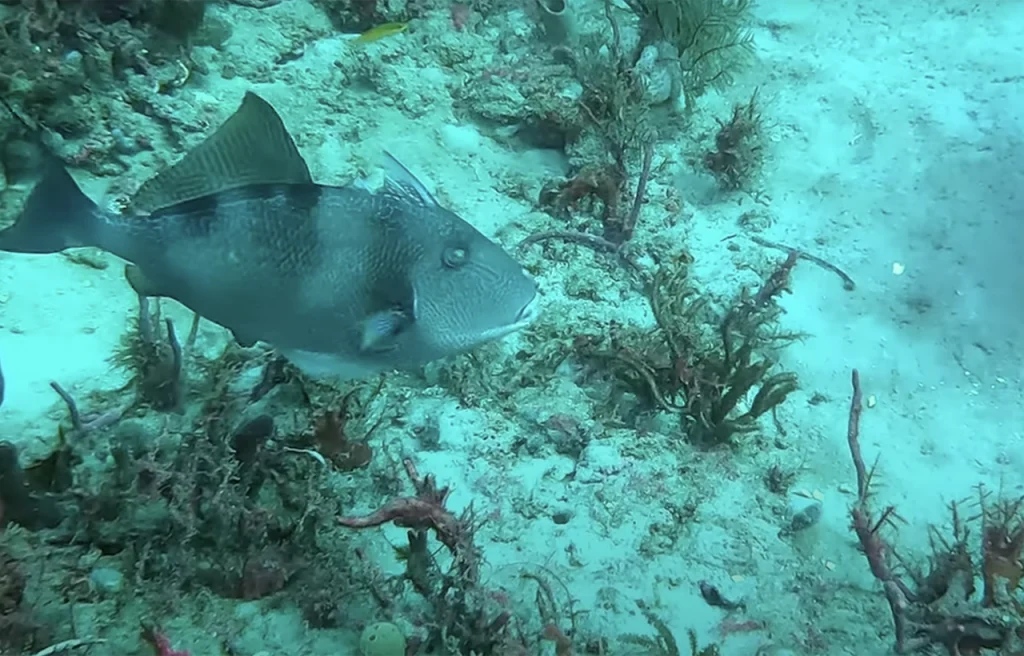
Maximizing Your Diving Experience at Bath and Tennis Reef
Optimal Diving Conditions
- Time of Year: Dive during the summer months (May to August) for the best visibility (40–50 feet) and warm water temperatures (around 76–82°F).
- Drift Diving: Take advantage of the mild Gulf Stream currents for effortless drift diving, allowing you to cover more of the reef without expending much energy.
- Morning Dives: Early morning dives often provide calmer seas and better light for viewing the reef’s vibrant coral formations.
Marine Life Encounters
- Turtles: Look out for loggerhead, hawksbill, and green turtles, which are frequently spotted resting under ledges or swimming alongside schools of fish.
- Eels and Sharks: Green moray eels are common at cleaning stations, while nurse sharks and occasional reef sharks may appear during your dive.
- Tropical Fish Schools: Schools of grunts, porkfish, angelfish, and spadefish hover above the reef, creating mesmerizing underwater scenes.
Must-See Features
- Honeycomb Holes: Explore the reef’s honeycomb-like structures, which are excellent hiding spots for lobsters and other invertebrates.
- Ledges and Crevices: Investigate six-foot-high ledges and small crevices that serve as habitats for juvenile fish, crustaceans, and bottom-dwelling species.
- Wreck Remnants: Discover small wreck fragments scattered around the reef, adding an element of exploration to your dive.
Photography Opportunities
- Bring an underwater camera to capture:
- The vibrant coral colors illuminated by sunlight.
- Unique marine behaviors, such as gobies cleaning larger fish or turtles interacting with their environment.
- Dramatic underwater topography like ledges and sponge-covered reefs.
Preparation Tips
- Gear Check: Ensure your gear is in excellent condition. A dive light is helpful for exploring crevices.
- Dive Guides: Consider hiring a local dive guide to point out hidden marine life and navigate the reef effectively.
- Mooring Buoys: Use mooring buoys when available to avoid damaging the reef with anchors.
Nearby Sites
For a well-rounded experience, combine your dive at Bath and Tennis Reef with nearby sites like:
- Breakers Reef: Known for its abundant marine life, including large schools of fish and multiple turtle species.
- Flower Gardens Reef: A colorful site with sponges, corals, and diverse sea life at slightly deeper depths (50–70 feet).
Capturing Memories at Bath and Tennis Reef: Photography Tips
Equipment and Setup
- Camera and Housing: Choose a reliable underwater camera housing that fits your camera model. Consider adding a wide-angle lens for reefscapes or a macro lens for small marine life like nudibranchs and shrimp.
- Strobes and Lighting: Use external strobes or video lights to illuminate the reef and reduce shadows. Position strobes at an outward angle to minimize backscatter caused by particles in the water (9).
- Filters: Use color-correcting filters (red or magenta) to restore natural colors lost at depth, especially if not using strobes.
Shooting Techniques
- Get Close: Minimize the distance between you and your subject (ideally within 12 inches) to reduce water distortion and loss of color, contrast, and sharpness.
- Shoot Upwards: Position yourself below your subject and shoot upwards to create dramatic compositions with vibrant blue water backgrounds.
- Focus on Eyes: Ensure the eyes of marine life are in focus for engaging portraits.
- Use Natural Light: Shoot with the sun behind you for even lighting and rich blue tones. Avoid shooting into the sun to reduce backscatter (8).
Composition Tips
- Reefscapes: Capture the reef’s ledges, crevices, and coral formations using a wide-angle lens. Include schools of fish or turtles for scale and interest.
- Macro Subjects: Focus on small details like gobies at cleaning stations or colorful coral textures. Use a macro lens or wet lens attachment for sharp close-ups.
- Fill the Frame: Avoid centering subjects; instead, use the rule of thirds to create balanced compositions.
Environmental Considerations
- Buoyancy Control: Perfect your buoyancy to avoid damaging corals or stirring up sediment that can ruin photos.
- Respect Marine Life: Do not touch or disturb marine creatures. Be patient and let them behave naturally for authentic shots.
Post-Dive Tips
- Review your photos after each dive to adjust settings as needed.
- Edit images using software like Lightroom to enhance colors, reduce noise, and crop for better composition.
Frequently Asked Questions
When is the best time to dive Bath and Tennis Reef?
The best time to dive Bath and Tennis Reef in Palm Beach is from May to August, based on favorable conditions and marine life activity:
Reasons May to August is Ideal
Water Temperature: During these months, water temperatures range from 27°C (81°F) to 29°C (84°F), providing warm and comfortable diving conditions.
Visibility: Visibility is typically excellent, reaching up to 25 meters (80 feet) on calm days, especially during summer.
Marine Life: This period coincides with peak sightings of loggerhead turtles, as many adults frequent the reef for feeding and resting.
Calm Seas: Summer months often bring calmer seas and mild currents, making it easier for divers of all levels to explore the reef’s ledges, crevices, and vibrant coral formations.
Additional Tips
Early morning dives are recommended for the calmest waters and best light conditions.
Book dives in advance during this season, as it is popular among divers due to the excellent conditions.
What is the visibility like while diving Bath and Tennis Reef?
The visibility while diving at Bath and Tennis Reef typically ranges from 30 to 50 feet(approximately 9 to 15 meters).
General Visibility: Divers have reported visibility of 30-40 feet on various occasions, with some dives experiencing even clearer conditions up to 40-50 feet.
Seasonal Variations: Visibility can vary depending on the season and weather conditions. During the summer months, particularly from May to August, divers often enjoy optimal visibility due to calmer seas and warmer water temperatures.
Impact of Marine Life: On days when visibility isn’t at its best, divers have noted that fish activity seems heightened, making for engaging encounters despite the reduced clarity.
How deep are the dives at Bath and Tennis Reef?
Dives at Bath and Tennis Reef typically range in depth from 19 to 59 feet (approximately 6 to 18 meters). More specifically, some reports indicate that the depths can vary between 42 to 53 feet (about 13 to 16 meters), with certain areas reaching up to 60 feet(approximately 18 meters).
This range makes the site accessible for divers of various experience levels, providing opportunities to explore vibrant marine life and coral formations within a manageable depth.
Is Bath and Tennis Reef suitable for beginners?
Yes, Bath and Tennis Reef is suitable for beginner divers due to its moderate depth range, gentle currents, and accessible features.
Beginner-Friendly Features
Depth Range: The reef’s depth ranges from 42 to 53 feet (13 to 16 meters), which is manageable for entry-level divers with Open Water certification.
Mild Currents: Currents at this site are typically mild or non-existent, making it easier for beginners to navigate and enjoy the underwater environment without feeling overwhelmed.
Good Visibility: Visibility is usually 30 to 50 feet, providing clear views of marine life and reef structures, which enhances the experience for less experienced divers.
Marine Life: The reef offers abundant marine life, including turtles, eels, and tropical fish, making it an exciting yet approachable site for new divers.
Additional Considerations
Beginners should dive with a guide or instructor familiar with the site to ensure safety and maximize their experience.
Drift diving is common at this site, so understanding basic buoyancy control is helpful.
Is Bath and Tennis Reef suitable for advanced divers?
Yes, Bath and Tennis Reef is suitable for advanced divers, offering several appealing features:
Advanced Diving Opportunities
Depth Range: The reef reaches depths of up to 60 feet (approximately 18 meters), allowing advanced divers to explore deeper sections and engage in more complex dive planning.
Marine Life Interactions: Advanced divers can take advantage of the opportunity to observe larger marine species, such as nurse sharks and various types of eels, which may be less commonly seen in shallower waters.
Drift Diving: The mild currents at Bath and Tennis Reef make it an excellent site for drift diving, a technique often favored by more experienced divers. This allows for longer dives while covering more area effortlessly.
Exploration of Features: The reef’s ledges, crevices, and potential wreck remnants provide advanced divers with the chance to navigate and explore varied underwater topography.
Considerations for Advanced Divers
Dive Planning: Advanced divers can enjoy the freedom of planning their dives, including exploring specific areas of the reef that might be less frequented by novice divers.
Environmental Awareness: Experienced divers can engage in conservation efforts by participating in activities like reef cleanups or monitoring marine life health.
Palm Beach Diving Sites
- Blue Heron Bridge
- Breakers Reef
- Flower Gardens
- Juno Ledge
- King Neptune
- Northwest Double Ledges
- South Double Ledges
- Cable Crossing
- Breakers 3rd Window
- Rons Rock
- Ballentine Reef
- Worth Avenue Pier Debris
- Playpen or Playground
- Bath and Tennis
- North and South Turtle Mounds
- Shark Canyon
- Larsens Valley
- Hole in the Wall
Reference List
- (1) Conservation
- (2) CORAL REEF CONSERVATION: WHY IT MATTERS
- (3) Dedicated to coral conservation through education, research, and restoration.
- (4) The Southeast Florida Marine Debris Reporting and Removal Program
- (5) DIVE AGAINST DEBRIS DATA SUBMISSION Bath & Tennis Reef 3 August, 2013
- (6) Florida’s Coral Reef Conservation
- (7) Environmental Resources Management
- (8) How to photograph coral reefscapes
- (9) Underwater Tips for photographing coral

